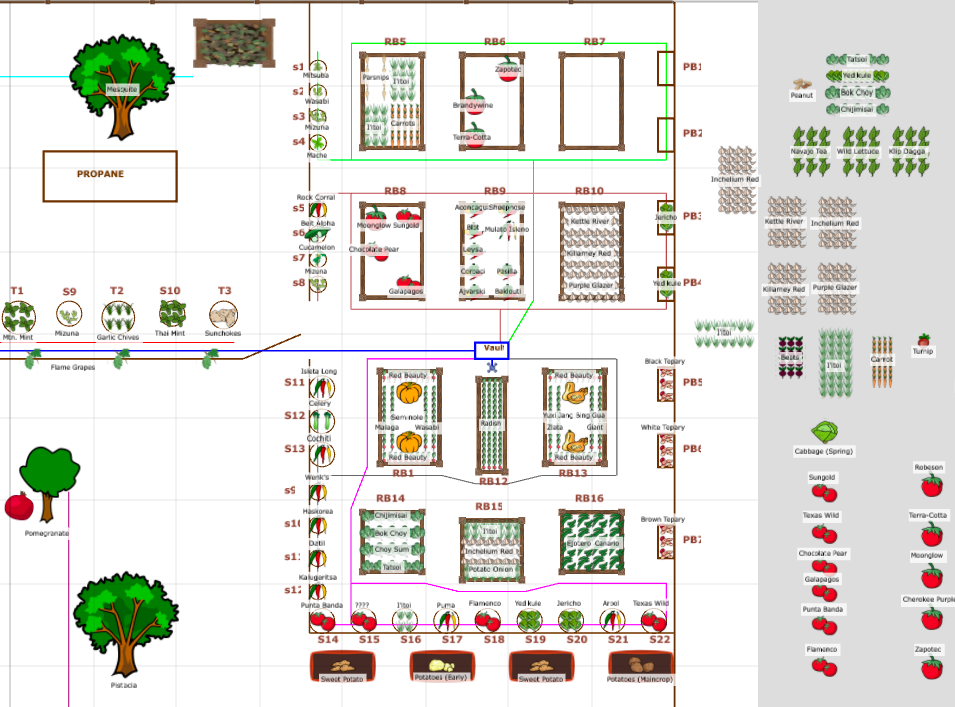Dan set up a full vegetable garden in the Southwest—from scratch! Everyone has garden challenges, and it’s impressive to learn from Dan, who successfully tackled critter protection, huge temperature swings, irrigation, and seed-saving. See his garden plan and photos, too.
Dan G.’s Garden Story
In 2012, we bought a fixer-upper in rural central Arizona at 3400’ elevation. The property is located in a valley at the end of a canyon with a very unusual microclimate, a riparian area with two year-round creeks. It is a
quarter acre and was mostly bare, with four mesquite trees and useless dirt
(caliche) for growing anything but native plants.
I started by putting a 6-foot
chainlink fence around the side and rear yards. There are lots of critters here! There
had been a small garden in the southwest corner that hadn’t been tended for a
few years. That’s where I started by expanding it to a 20’x20’ area
with six 4’x6’ raised beds out of 2x12s and some 5-gallon containers.
I added drip irrigation and a lot of compost from the local nursery (about
eight cubic yards as they had a huge pile). It was composted chicken manure, worm
castings, bone meal, etc. Then, off to the races!!
So what to grow? We can grow year-round here, but first, I must
explain our seasons. It’s below freezing at night from November through March, along with 70s and 80s during the day. April through June stays below
100, and July through September can reach 115. Fortunately, temperatures are in the
60s at night. Nice, but some plants can’t handle 50-degree temperature swings
every day. Hence, much research on the internet and local sources is needed.
I got a few seeds from neighbors and a local seed bank, just enough to get
started. I discovered Rare Seeds during online
searches. Rare Seeds offer seeds from similar climates around the world
, and Native Seeds cover indigenous seeds from the Southwest.
After a few
years, I’ve found compatible plants while saving seeds from my most
successful crops. Now, half of the garden is growing plants from seeds
that have thrived here for centuries. The rest of what I grow is kind of
’let’s see what happens’. I have found seeds from around the world
that can handle it here. Asian, East Mediterranean, North African—they
all have something growing in my garden. Mostly, though, it’s Sonoran,
which has grown here for centuries.
In 2014, I found the online Garden Planner, and it has been a great asset ever
since. For the past nine years, it has helped me plan, design, expand, and manage a
2000+ square-foot garden and orchard with 16 raised beds, 34 grow sacks, seven gearboxes,
three tubs, and four planter bags with two each 4’x25’ stepped planters. I have drip
irrigation throughout and a lot of 40% shade cloth. This is evident in
my current plan.
With the Garden Planner, crop rotation is easy to track and plant in the database, which is quite helpful. I
don’t use the Journal very much, but I should. I frequently publish my
plans and save them as jpg’s. I import them into a spreadsheet to integrate them with all my irrigation calculations and monitor
daily weather (temps, rain, snow). I can control irrigation for eight zones
, including each RB, planter, and grow bag or container in each zone, according to
what’s planted. (I track my iterations this way instead of saving dozens
of plans on your servers.)
Dan G.’s Vegetable Plot Plan
Dan and his wife live in central Arizona between Flagstaff and Prescott (Zone 8b), a semi-arid climate. The vegetable layout was designed with the Almanac Garden Planner. Note: This is not the entire plan, but it covers the main garden.

The Garden Photos!






Learn more about the Garden Planner to create your productive garden!
See more examples of garden plots.

















